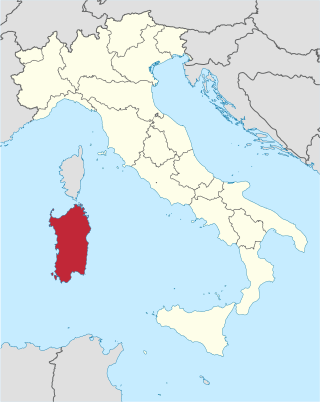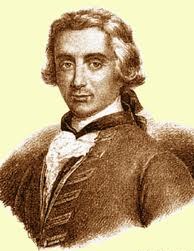
Nuoro is a city and comune (municipality) in central-eastern Sardinia, Italy, situated on the slopes of Mount Ortobene. It is the capital of the province of Nuoro. With a population of 36,347 (2011), it is the sixth-largest city in Sardinia. Its frazione (borough) of Lollove is one of I Borghi più belli d'Italia.

Sardinia is the second-largest island in the Mediterranean Sea, after Sicily, and one of the twenty regions of Italy. It is located west of the Italian Peninsula, north of Tunisia and 16.45 km south of the French island of Corsica.

Luigi Amat di San Filippo e Sorso was the dean of the College of Cardinals during the last part of the record long reign of Pope Pius IX.

Vicente Bacallar y Sanna, 1st Marquess of San Felipe, later italianized into Vincenzo Bacallar Sanna, was a Sardinian nobleman, military officer, linguist, historian, politician and ambassador of the Spanish Empire. He was born to a noble Sardinian family when the kingdom of Sardinia was part of the Spanish crown.

From 1700 to 1720, the Kingdom of Sardinia, as a part of the Spanish empire, was disputed between two dynasties, the Habsburgs and the Bourbons. With the death of Charles II, the last of the Spanish Habsburgs, on 1 November 1700, the throne passed to Duke Philip of Anjou, although the Emperor Leopold I also had a claim. Leopold was especially desirous of obtaining the Spanish inheritance in the Southern Netherlands and in Italy, which included Sardinia. With the failure of France to abide by the Second Partition Treaty, the other European powers lined up on the side of the Habsburgs. The Treaty of the Hague allotted to the Emperor the Spanish possessions in Italy. Imperial troops invaded Italy to seize them, and the War of the Spanish Succession began.

Sardinian nationalism or also Sardism is a social, cultural and political movement in Sardinia calling for the self-determination of the Sardinian people in a context of national devolution, further autonomy in Italy, or even outright independence from the latter. It also promotes the protection of the island's environment and the preservation of its cultural heritage.

The literature of Sardinia is the literary production of Sardinian authors, as well as the literary production generally referring to Sardinia as an argument, written in various languages.
This article presents a history of Cagliari, an Italian municipality and the capital city of the island of Sardinia. The city has been continuously inhabited since at least the neo-lithic period. Due to its strategic location in the Mediterranean and natural harbor, the city was prized and highly sought after by a number of Mediterranean empires and cultures.
Marquis of Villahermosa e Santa Croce is a title first granted in 1745 by Charles Emmanuel III, king of Sardinia to the Sardinian merchant Bernardino Antonio Genovès. It has passed afterwards to a branch of the house Manca, called Manca di Villahermosa since.
Marquis of Neoneli is a title granted in 1774 by Victor Amadeus III of Savoy, king of Sardinia, to Sardinian nobleman Pedro Ripoll. It has passed afterwards to the house Sanjust.
Marquis of San Sperate is a title granted in 1749 by Charles Emmanuel III of Savoy, king of Sardinia, to Sardinian judge and nobleman Joseph Cadello. It has passed afterwards to the house Ripoll and eventually to Sanjusts.
Marquis of Montemuros, also called Monte Muros, is a title granted in 1762 by Charles Emmanuel III of Savoy, king of Sardinia, to Sardinian nobleman and lord Pedro Martinez. It got extinguished in 1918.
Marquess of Soleminis is a title granted in 1651 by Philip IV, king of Spain and king of Sardinia, to the Sardinian nobleman Francisco Angel Vico Sonza. It has passed afterwards to the house Amat.

Pietro Amat di San Filippo was an Italian geographer, historian and bibliographer.

The Byzantine age in Sardinian history conventionally begins with the island's reconquest by Justinian I in 534. This ended the Vandal dominion of the island after about 80 years. There was still a substantial continuity with the Roman phase at this time.
Duke of Vallombrosa was a title created for the House of Manca. The present holder is disputed.

Sardinian surnames are surnames with origins from the Sardinian language or a long, identifiable tradition on the Western Mediterranean island of Sardinia.










